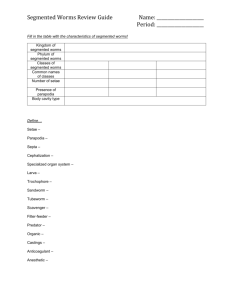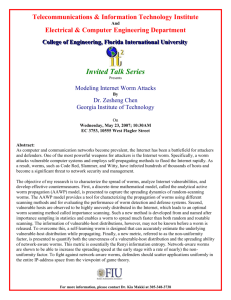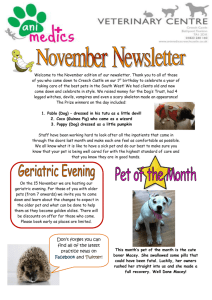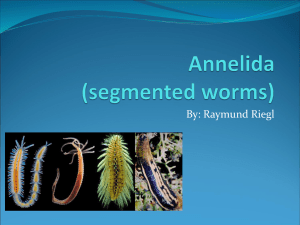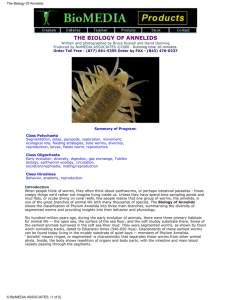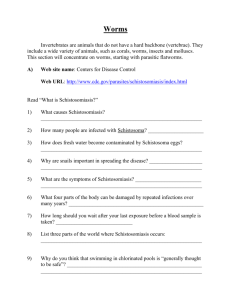phylum annelida
advertisement
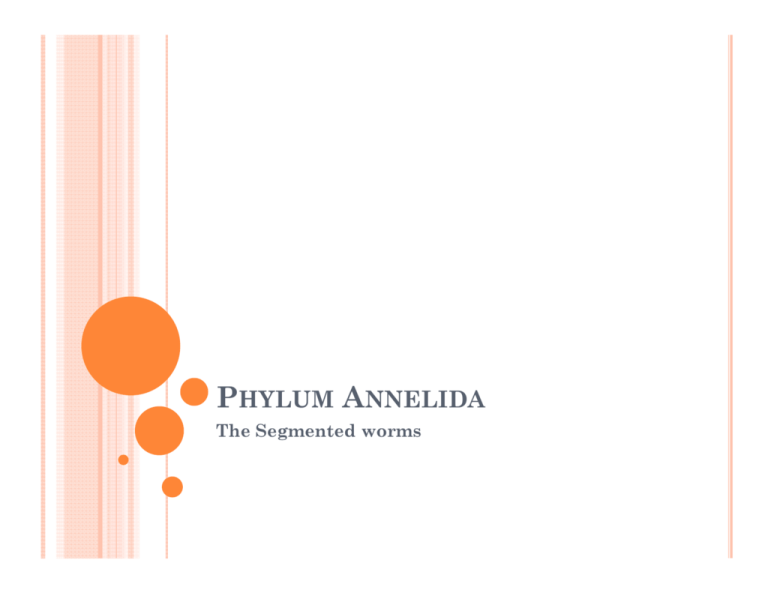
PHYLUM ANNELIDA The Segmented worms WHAT IS A SEGMENTED WORM? GENERAL CHARACTERISTICS OF PHYLUM ANNELIDA 1. Coelom and bilateral symmetry 2. Segmented body (Metamerism) 3. Paired hairs or bristles found on their body (Setae) 4. Closed circulatory system with multiple “hearts” 5. Excretory system (Metanephridia) 6. Complete digestive system 7. Monoecious or dioecious BODY STRUCTURE It has a Coelom!!! For your notes, write the items in red SEGMENTATION- METAMERISM Body has ring-like segments Divided internally Growth occurs at the posterior end Each segment has a pair of bristles SEGMENTATION- METAMERISM What are the advantages to body segments? Creates hydrostatic compartments that can be individually controlled Greater variety of movement Lessens injury impact. Other segments can perform the same functions Allows for regions to be specialized Feeding, movement, reproduction FEEDING AND DIGESTION Aquatic worms filter feed Earthworms have a crop, muscular pharynx, gizzard and intestine CIRCULATION Closed circulatory system- vessels carry blood Expanded vessels act like hearts Contract to pump the blood RESPIRATION Aquatic annelids use gill-like structures Terrestrial annelids rely on moist skin and diffusion O2 diffuses in and CO2 diffuses out EXCRETION Cellular waste is filtered from the fluid of the coelom by metanephridia RESPONSE AND SENSES Have a brain and nerve cords Ventral nerve cord has ganglia RESPONSE AND SENSES Marine annelids have sensory structures • Tentacles, chemical receptors, statocycts and 2 or more pairs of eyes MOVEMENT Circular • • and longitudinal muscles contract with hydroskeleton Alternately contract Bristles give it traction REPRODUCTION Most annelids reproduce sexually Earthworms are hermaphrodites All monoceious Both worms give and receive sperm Clitellum- saddle like structure Slides off the worm and forms cocoon for eggs CLASS POLYCHAETA Polychaetes are marine worms Fan worms, feather worms tube worms, bristle worms, clam worms Live on the ocean floor Under rocks and sand burrows Heads have sensory structures Eyes, antennae, palps Parapodia Some can regenerate CLASS CLITELLATA Earthworms, leeches and their friends EARTHWORMS Scavengers Burrowers that eat dead vegetation LEECHES Eat invertebrates or vertebrate body fluids No internal segments Ends modified into suckers Secrete hirudin as anticoagulant One feeding lasts months Increases 2- 10 times original size Medicinal use TIME TO INVESTIGATE Choose one of the following leads and research the topic. Write a summary that gives the details of what you learned and mention why it is cool/interesting to you. Giant Earthworms Medicinal leeches and their rising use Giant tube worms Christmas tree worms The benefits of earthworms to the soil VIDEO LIST Shape of Life Overview: http://shapeoflife.org/annelid Tube worms: http://www.arkive.org/giant-tube-worm/riftiapachyptila/video-00.html http://www.bbc.co.uk/nature/life/Giant_tube_worm Feather worms – aquarium http://www.youtube.com/watch?v=kIoN2PCvL4o Bristle worm: Plume Worm: http://video.nationalgeographic.com/video/animals/invertebra tes-animals/other-invertebrates/worm_plumed/ Terebellid Worm http://video.nationalgeographic.com/video/animals/invertebra tes-animals/other-invertebrates/worm_terebellid/ Leech moving, sucking: http://www.arkive.org/medicinalleech/hirudo-medicinalis/video-00.html Earthworms: Leafy Lunch http://www.bbc.co.uk/nature/life/Lumbricidae#p01jwh21





